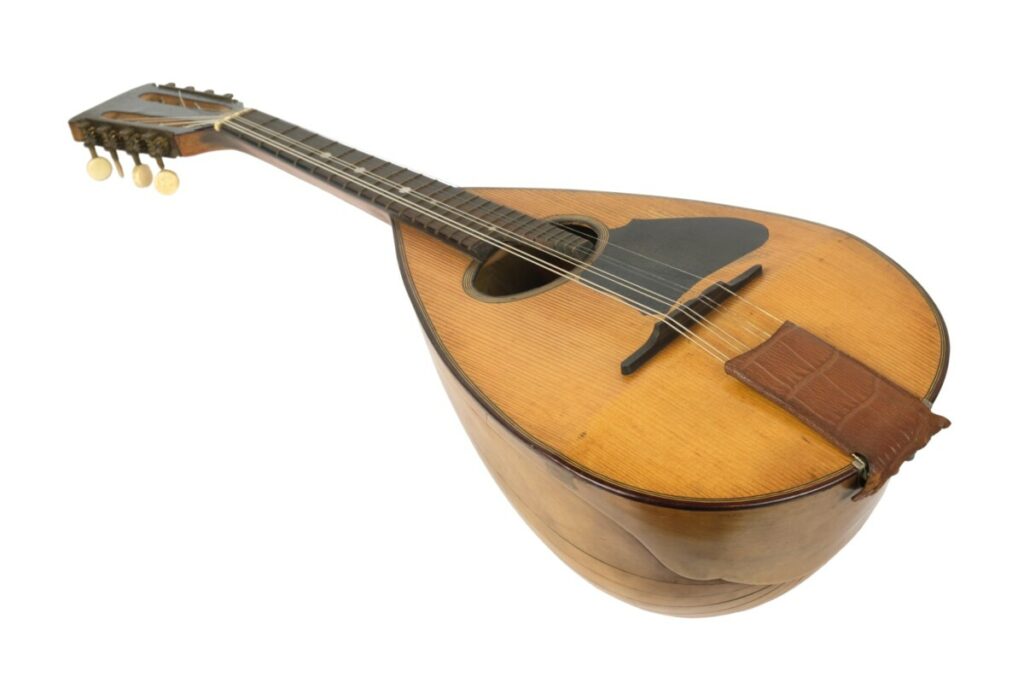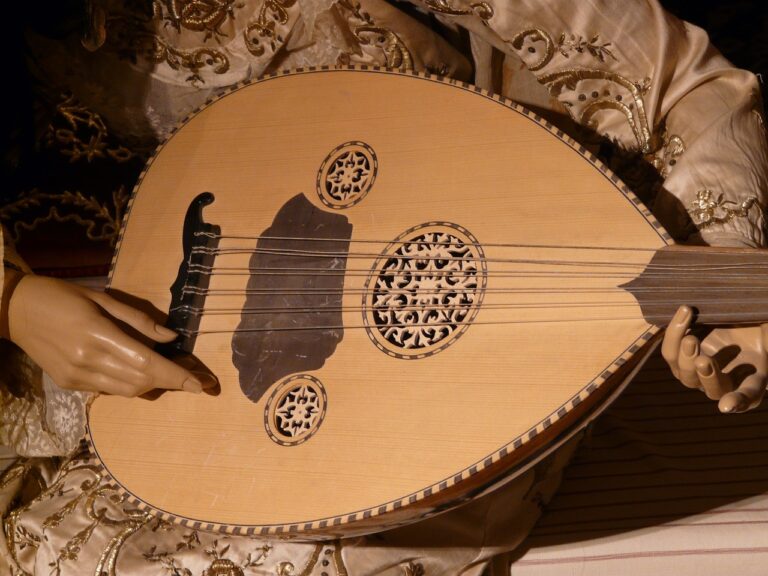How Many Strings Does a Mandolin Have?

There are a lot of stringed instruments that seem to be similar but are quite different. While most of these instruments have four strings, a mandolin is unique because of its many strings. So, how many strings do mandolins have?
A mandolin traditionally has eight strings arranged in four pairs of two. Since the strings are designed to be played in pairs, the mandolin is played similarly to other four-stringed instruments like guitars.
A mandolin’s distinctive strings give the instrument a unique challenge. Keep reading to learn more about how mandolin strings are arranged, how to tune a mandolin, and whether or not it is hard to play.
What is a Mandolin?
Like guitars, mandolins are built of two different parts: a resonator and a neck. The resonator, or the body, amplifies the sounds plucked on the neck’s strings. The neck holds the strings, separating each note by a series of frets.
What makes a mandolin unique is that its body doesn’t maintain the notes for as long as an acoustic guitar. Instead, the notes become quiet faster, encouraging the player in faster picking.
This is why mandolin music throughout the 20th century (in the West) was bluegrass, as it was a natural fit for twangy, fast music. It also found a home in traditional folk music.
The Mandolin was popular throughout the early 19th century. But its origins go back to the 17th century when the precursor instruments (the mandore and mandola) were popular.
The most popular type of mandolin is the Neapolitan mandolin, which is what you are most likely familiar with. Mandolins also come in different sizes (like ukuleles), tuned to different octaves.
How are Mandolin Strings Arranged?
The eight strings on a mandolin are each strung from the head to the end of the instrument and are fastened to pegs at the head. Although there are eight strings, you may not notice all of them at first glance because of how they are arranged.
The strings are lined up in pairs, so two strings are placed very close to each other but aren’t touching. A much larger space between each set of pairs allows the player to easily place their finger or thumb on both strings at once and not touch the next couple.
Even though there are eight strings, you can only play four notes on the mandolin. The pairs are designed to be played simultaneously because they should be tuned to the same note.
Like a guitar, the strings are placed from low to high notes. Mandolins, unlike other musical instruments, are unique because of this double strings approach.
Despite the extra strings, the neck of a mandolin has a smaller neck width than a guitar. The strings are quite close, but the gaps between each pair are smaller than the typical gap between each string on a guitar.
How to Tune Mandolin Strings

Tuning a mandolin takes twice the time and effort as a four-stringed instrument, but the process is similar. The traditional guitar tuning process is essentially duplicated.
Instead of going through the strings and tuning G – D – A – E, the mandolin goes G – G – D – D – A – A – E – E. The mandolin has a separate tuning knob for each of its eight strings. You have to tune each string individually even though the notes repeat.
The pairs of strings will be played simultaneously, so accurate tuning is even more important than usual. If a string is slightly out of tune, it will sound weird when played with its paired string.
Different Tools for Tuning The Mandolin
There are many different tool options for mandolins, but a digital tuning device will probably be the easiest and most accurate to use.
You could also download a tuning app that will function similarly to a clip-on tuner. If you want to make your mandolin playing even easier, some products will twist the knobs for you until each string is perfectly tuned. The tuning device you use does not need to be specifically designed for mandolins, so you can use almost any tuning device.
- THE STEALTH TUNER – Your audience will never know there is a tuner on your instrument with the highly precise Micro Clip-On Tuner. The lightweight, discrete, compact tuner hides behind the headstock practically blending into the instrument and is small enough to be kept on your instrument while stored in its case. At 1.25″, you will want one for each stringed instrument you own.
- EXTREME ACCURACY – The NS Micro features an extremely accurate piezo transducer that picks up an instrument’s vibration rather than sound. A wide calibration range (410-480Hz) guarantees precise performance.
- EASY TO READ – The easy-to-read, tri-color backlit screen displays the note in red when out of tune, yellow when close, and green when in tune. Powered by a readily available (and included) CR2032 battery, you will enjoy maximum battery life thanks to the tuner’s auto-off function.
- VERSATILE – Featuring a 360-degree swivel mechanism and adjustable padded clamp, the NS Mini offers optimal viewing angles and maximum positioning flexibility. For left or right-handed instruments with small or large headstocks, it is the ideal choice for acoustic and electric guitars, basses, mandolins, banjos and ukuleles.
- D’ADDARIO ACCESSORIES – For over 20 years, D’Addario Accessories (formerly Planet Waves) has been leading the industry in innovative and problem-solving products that serve musicians worldwide. D’Addario Accessories are proudly made in a state-of-the-art manufacturing facility to the most stringent quality controls in the industry.
- Highly sensitive tuner, metronome beat mode, suitable for music teachers, professional and junior players even in noisy environments.
- Variety of tuning: 6 C standard pitch bass and string instruments, guitar, bass, ukulele, violin, tuning range: OA (27.5Hz) -8C (4186.01Hz).
- Easy to read and set, clear LCD digital display, easy to read, automatically shut down if not played, automatic shutdown within 5 minutes.
- Environmentally friendly ABS plastic applications, no inferior materials. FCC and CE certification, lead-non certification.
- The JT-09 is a mini and precise guitar tuner.If threre are any problem after receiving the parcel, you can describe problem to me at any time, I will solve it in 24hrs
- Clip-on tuner that utilizes a high-sensitivity vibration sensor or an internal microphone
- High definition, full-color display that rotates 360°
- Boasts a faster and more accurate tuning chip
- Has a stay-put clip, a tap tempo metronome, and it has pitch calibration from 415 to 466 Hz
- Features an extended frequency range and is compatible with all instruments
- QUICK TUNING: Tune your guitar or bass with ease with the Nexxus 360 Rechargeable Guitar Tuner. Featuring quick and accurate tuning, large screen, and strong clamp that rotates 360-degrees for a variety of viewing angles.
- RECHARGEABLE GUITAR TUNER: Enjoy 24 hours of guitar tuning time per charge without changing or buying batteries. Simply plug the supplied USB cable into any USB power device as needed.
- EXTREME ACCURACY – Great accuracy with a wide calibration range (415-465Hz) guarantees precise performance. Calibration is also adjustable.
- BRIGHT SCREEN THAT ROTATES: Extra bright LED display for tuning your instrument in various lighting conditions. Display rotates 360-degrees to your viewing position needs.
- STRONG CLAMP: The Nexxus 360 clip on guitar tuner can be mounted anywhere on the headstock without worries of slipping.
If you cannot get a tuning device or app, you can tune your mandolin strings the old-fashioned way and use trial and error to find the right note. Use an instrument like a keyboard or tuning fork to help you adjust your mandolin.
If you do it by ear, be careful to play each string in a pair separately and together. This ensures that they sound the same. A pick will help you play each string individually, even though they are so close together.
What Can Be Played on the Mandolin?
A mandolin can play melodies or chords, depending on what you prefer. A well-versed mandolin player will likely know eight major chords, six minor chords, and four seventh chords, for 18 chord options. You can vary the octave by moving up and down the frets in intervals.
Interval work combined with tons of chords and different strumming patterns gives you almost infinite options for creating music on the mandolin. The extra four strings do not add note options but help give the mandolin a distinct sound.
Mandolins can be used as a solo instrument or a backup instrument. They were originally used in classical music and are now commonly used to play bluegrass and folk music. The unique string pattern allows mandolins to shine however you use them.
Is it Difficult to Play the Mandolin?

The difficulty of playing the mandolin depends on your previous musical experience. It will probably be tricky if you have never played a string instrument.
Anyone who has played the guitar, ukulele, or another similar instrument can pick it up quickly. You just have to get used to the brighter tone if you’ve played the guitar. The tuning process is extremely similar, you’ll also find playing techniques similar to other string instruments.
The biggest difference is getting used to playing in pairs rather than playing one string at a time. To play the mandolin, you must practice holding a pair of strings simultaneously with even pressure to get the same note from each string in the pair.
You must also practice a new strumming pattern that enables you to control eight strings instead of four. Players used to a guitar may find it challenging to get used to the smaller spacing between strings, as the neck on a modern mandolin is fairly thin. Playing the mandolin is only slightly more difficult than playing the guitar.
You can play the mandolin with just your fingers, but you can also use helpful tools if you prefer to do so. A capo can help you easily play notes in different keys. A pick can help you isolate strings easier and create a cleaner sound.













